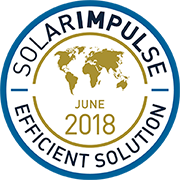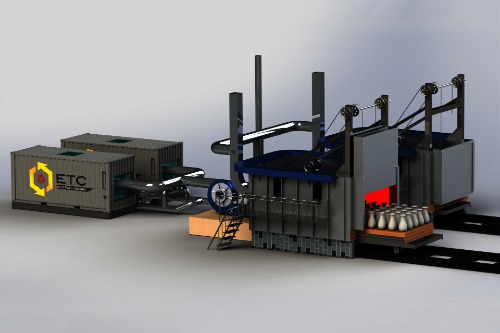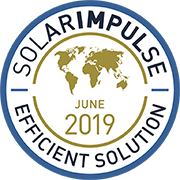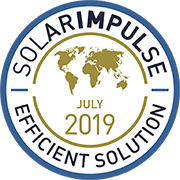News - October 5, 2020
Energy efficiency: an actionable lever for the energy transition


Written by Expert: Sandra Hounkonnou 5 min read
In this Technical Article, Sandra Hounkonnou, Group Environmental Footprint Coordinator at Fives and Expert at the Solar Impulse Foundation discusses how energy efficiency underpins the transition to a clean future.
After the industrial and the digital revolutions, the world now enters a sustainable revolution with many challenges to overcome, the global energy transition being one of the most critical.
Whether it be for agriculture, industry, buildings or transportation, our economy is heavily dependent on fossil energy. In 2019, the energy-related CO2 emissions remained unchanged at 33 gigatons, while the global economy grew by 2.9% [1]. This was mainly due to a strong growth of renewables worldwide, and to natural gas replacing coal as well as increasing nuclear generation in some geographies.
All this is very good news…but is it enough?
Low-carbon energies are necessary, but not yet sufficient
Wind and solar energy are projected to represent a growing share of the electricity generation in the coming years. In 2019 they reached 67% of the new power capacity globally added [2], and in two-thirds of the world, new wind or solar assets were more cost-competitive than fossil-fuel power plants [3]. However, their variable output remains a drawback in comparison with thermal plants, even if high-performance storage solutions are emerging.
Geothermal power and hydroelectric plants can produce continuously or on-demand, but they are limited by geographical conditions. Similarly, biomass and biogas could be sustainable solutions but their development competes with other uses like agriculture, transportation and industry. Nuclear energy is a reliable low carbon energy source but raises many issues, spanning from radioactive waste management risks to nuclear safety and security considerations, not to mention soaring construction costs of new generation nuclear plants. Hydrogen obtained by water electrolysis using carbon-free electricity offers strong prospects for transportation, high temperature heat, or as a storage medium in support of renewable power generation. Nevertheless, scaling up hydrogen’s use and production faces considerable financial and technical constraints.
Much of the energy transition focuses on cleaner energies. Yet, as highlighted above, their respective shortcomings represent major barriers in order to cover the global energy demand which is expected to rise by 1% annually until 2040 [4].
There is therefore an urgency to moderate the energy needs of our global economy. As industry and services represent nearly 40% of the global energy consumption [5], the corporate world has a key role to play: energy efficiency should be at the core of companies’ priorities.
Energy efficiency as a competitive advantage
Tackling energy efficiency can lead to significant improvement of companies’ operational performance through various aspects:
Reduction of energy bills: implementing energy efficiency retrofits and upgrades can generate from 10% to 30% savings on companies’ energy expenses and involves average payback times below 3 years [6]
Modernisation of infrastructure: optimising existing assets helps avoid future investments that may not pay-off, and increases competitiveness
Anticipating emerging regulations: stepping forward on new energy-efficiency regulations has a strategic value-added. It limits risk exposure to penalties while opening access to subsidies and funding programs
Less vulnerability to energy resource scarcity: securing energy supply is a vital concern for companies and failure in that regard may threaten its business longevity. Energy efficiency offers a lever to reduce the level of dependence of companies’ supply chain to energy
According to research by McKinsey [7], a strong sustainable proposition can not only help companies tap into new markets and expand into existing ones, but can also attract quality employees and enhance employee motivation and productivity.
The global building efficiency market has more than doubled between 2013 and 2018 [8], and investments in energy efficiency create three times more jobs than those in fossil fuel [9]. Delivering more energy efficient products to its customers can bring new business opportunities and jobs creation.
Proactive engagement in energy efficiency, as well as its integration in corporate value proposition can unleash growth potential for organisations. Options to bring a radical change in our energy usage already exist.
We have the solutions at hand
Significant changes in consumer behaviour are necessary to reduce energy needs, but efficient technologies are also crucial. Fortunately, solutions are readily available to tackle this energy efficiency challenge, including those achieving the Solar Impulse Efficient Solution Label.
Recovering heat losses in industry
There is a strong focus on electricity in the energy transition effort but heat actually represents the largest energy end-use: in 2018, it accounted for 50% of the global final energy consumption [10]. Recovering and minimizing heat losses is thus of the utmost importance in the race for energy efficiency, especially in industry.
The following innovative Solar Impulse Efficient Solutions could be used to recover heat losses:
EcoStock stores industrial waste heat in recycled ceramics to provide hot air up to 1000°C or to generate electricity: one unit can save up to 8000t of CO2 in its lifetime
Qpinch uses a physico-chemical reaction to release captured waste heat at a higher temperature
Equium and Stirling Engine respectively allow to recycle waste heat into cooling and to use it for on-site electricity production
Minimising building energy consumption
Beyond industrial processes, heat losses are actually recurrent in buildings and can be reduced with highly efficient thermal insulations.
Several companies developed solutions based on recycled materials, thus lowering the environmental impact related to the production of insulating materials, while also saving energy significantly:
SICLA recycles construction and demolition waste to superinsulation products, allowing 40% energy savings in buildings
Gramitherm transforms grass from waste to insulation panels
CYNTHIA® uses a fiber obtained from the invasive water hyacinth
Revolutionising lighting technologies
Lighting is an energy use existing in any building regardless of its use or location. Hereafter innovations intending to revolutionise today’s lighting technologies:
Solatube tubular devices bring daylight into interior spaces where skylights and windows cannot reach, providing up to 100% of the lighting needs
SOLIS industrial collectors provide large amounts of sunlight to unlit rooms
Glowee uses bioluminescence to reduce the environmental impact of lighting
The number of game-changing solutions we can rely on to address energy efficiency is skyrocketing: winning the energy efficiency race is technically and economically possible. The Efficient Solution Label brings to light innovations which are both sustainable, profitable, and actionable, and browsing the Solar Impulse portfolio is a first step that any company can take on the road to energy efficiency.
Sources:
[1] IEA - Defying expectations of a rise, global carbon dioxide emissions flatlined in 2019
[3] Bloomberg - Solar, Wind Provide Cheapest Power for Two-Thirds of Globe
[4] IEA - World Energy Outlook 2019
[6] Carbon Trust - Energy Savings from Audits
[7] McKinsey - Five ways that ESG creates value
[8] Advanced Energy Economy - 2019 Market Report

Written by Expert: Sandra Hounkonnou on October 5, 2020





















